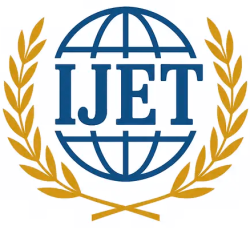
Autonomous Human Body Control, Part XIV: Serum Potassium Concentration Control during Hemodialysis using I- first Order and P-D Compensators Compared with a PID Controller – Volume 11 Issue 5

International Journal of Engineering and Techniques
ISSN 2395-1303
Volume 11, Issue 5 | Published: October 2025
Author
Galal Ali Hassaan
Table of Contents
ToggleAbstract
This paper investigates the tuning of I-first order and P-D compensators from the second generation of control compensators and a PID controller from the first generation of PID controllers to control the serum potassium concentration of the human body during hemodialysis. The proposed compensators are tuned using a hybrid approach based on zero/pole cancellation and the satisfaction of specific time-based characteristics of the closed-loop control system incorporating the compensator and process. The serum potassium concentration is modeled using pre-published hemodialysis profile-data and the tuning results of the proposed compensators/controller are presented and applied to generate the step time response for reference input tracking of a specific level within the normal limits of the serum potassium concentration. The characteristics of the step time responses are compared with those of the conventional PID controller. The best compensator/controller for the control of the human serum potassium concentration during hemodialysis is assigned. Clearance rate of serum potassium.
Keywords
Autonomous human body control, serum potassium concentration control during hemodialysis, PID controller, I-first order compensator, P-D compensator, controller/compensators tuning.Conclusion
-The research work presented in this research paper handled the tuning of two compensators from the second generation of control compensators proposed to control the serum potassium concentration of a human being during dialysis compared with a PID controller from the first generation of PID controllers. The controlled serum potassium concentration as a process was identified as a first-order one. Its parameters were identified using kinetic profile data from a previous research work. The proposed compensators were tuned using hybrid approach based on applying the zero/pole cancellation and specific step time response characteristics (critical damping, settling time and steady-state error). The PID controller was tuned using an ITAE performance index and MATLAB optimization toolbox. The proposed compensators/controller succeeded to eliminate completely the steady-state error of the control system. The proposed compensators/controller succeeded to eliminate completely the maximum percentage overshoot of the control system. The proposed compensators succeeded to reduce the settling time of the control system (with respect to the 2 % tolerance) to values in the range: 0.489 ≤ Ts2% ≤ 0.50 h compared with 2.3737 h for the PID controller. The proposed compensators succeeded to reduce the settling time of the control system with respect to normal potassium concentration limits to 0.1063 ≤ TsLimits ≤ 0.1667 h compared with 0.7419 h for the PID controller. The proposed compensators succeeded to reduce the delay time to 0.0867 ≤ Td ≤ 0.1438 h compared with 0.6080 h for the PID controller. The proposed compensators succeeded to reduce the rise time to 0.2746 ≤ Tr ≤ 0.2877 h compared with 1.5190 h for the PID controller. The best compensator is the P-D compensator based on the characteristics in Table 1. The effect of control system settling time to 2% tolerance (Ts2%) on the step response of the control system when the P-D compensator is proposed to control the serum potassium concentration was investigate for Ts2% in the range: 2 ≤ Ts2% ≤ 8 h. The effect of control system settling time to 2% tolerance (Ts2%) on the rate of potassium clearance during hemodialysis when the P-D compensator is proposed to control the serum potassium concentration was investigate for Ts2% in the range: 2 ≤ Ts2% ≤ 8 h. The maximum clearance rate was in the beginning of the step input activation depending on the settling time of the control system step time response. Future work is required to set limits for the clearance rate of serum potassium concentration to avoid cardiac effects and possibility of patient death during hemodialysis.
References
1. M. Kam, “Potassium disorder: Hypokalemia and hyperkalemia”, American Academy of Family Physicians, vol.107, issue 1, pp.59-79, 2023. 2.Cleveland Clinic, “Hyperkalemia (high potassium)”, https://my.clevelandclinic.org/health/diseases/15184-hyperkalemia-high-blood-potassium, 2025. 3.J. N. Cohn, et al., “New guidelines for potassium replacement in clinical practice: a contemporary review by the National Council on potassium in clinical practice”, Archives of Internal Medicine, vol.160, issue 16, pp.2429-2436, 2000. 4.A. Santoro, et al., “Electro physiological response to dialysis: The role of dialysate potassium concentration and profiling”, Contributions to Nephrology, vol.149, pp.295-305, 2005. 5.J. L. Sanchez, et al., “Hyperkalemia and hemodialysis patients: Electrocardiographic changes”, Journal of Renal Care, vol.33, issue 3, pp.124-129, 2007. 6.L. Gabutti, et al., “Haemodynamic consequences of changing potassium concentrations in haemodialysis fluids”, BMC Nephrology, vol.12, issue 4, 8 pages, 2011. 7.B. U. Agar, et al., “Dialysate potassium kinetics during hemodialysis”, Hemodial International, vol.19, issue 1, pp.23-32, 2015. 8.A. Karaboyas, et al., ” Dialysate potassium, serum potassium, mortality and arrhythmia events in hemodialysis: Results from the dialysis outcomes and practice patterns study ”, Journal of Kidney Diseases, vol.69, issue 2, 266-277, 2017. 9.F. Depret et al., “Management of hyperkalemia in the acutely ill patients”, Annual Intensive Care, vol.19, issue 32, 16 pages, 2019. 10.S. Shibata and S. Uchida., “hyperkalemia in patients undergoing hemodialysis: Its pathophysiology and management”, Apheresis and Dialysis, vol.26, pp.3-14, 2022. 11.H. Hamada, et al., “The impact of potassium dynamics on cardiomyocyte beating in hemodialysis treatment”, Journal of Clinical Medicine, vol.13, issue 2289, 14 pages, 2024. 12.D. M. Charyatan, et al., “Effects of dialysate potassium concentration of 3.0 mmol/L with sodium zirconium cyclosilicate on dialysis-free days versus dialysate potassium concentration of 2.0 mmol/L alone on rates of cardiac arrhythmias in hemodialysis patients with hyperkalemia”, Kidney International, vol.107, pp.169-179, 2025. 13.J. Kee and D. Mendelssohn, “Optimizing dialysate potassium”, Hemodial International, vol.20, issue 4, pp.573-578, 2016. 14.A. Awouda and R. Mamat, “New PID tuning rule using ITAE criterion”, International Journal of Engineering, vol.3, issue 6, pp.597-608, 2010. 15.M. Ancan, Practical optimization with MATLAB, Cambridge Scholars Publishing, 2019. 16.Mathworks, “Plotting system responses”, https://www.mathworks.com/help/control/ug/plotting-system-responses.html , 2024. 17.T. Huggland and J. Guzman, “Give us PID controllers and we can control the world”, IFAC Papers Online, vol.7, pp.103-108, 2024 18.G. A. Hassaan, “Autonomous vehicles control, Part I: Car longitudinal velocity control using P-D, I-first order, 2/2 second-order and notch compensators compared with a PID controller”, International Journal of Research Publication and Reviews, vol.4, issue 9, pp.334-344, 2024. 19.M. C. Campi, “The problem of pole-zero cancellation in transfer function identification and application to adaptive stabilization”, Automatica, vol.32, issue 6, pp.849-857, 1996 20.G. A. Hassaan, “Novel characteristics evaluation of critically damped second-order-like dynamic systems”, International Journal of Computer Techniques, vol.12, issue 5, pp.167-174, 2025. 21.G. A. Hassaan, “Tuning of a novel P-D compensator to control a highly oscillating second-order-like process”, International Journal of Emerging Engineering Research and Technology, vol.10, issue 1, pp.1-7, 2022. 22.Electrical for You, “First order control system: What is it?”, https://www.electrical4u.com/first-order-control-system/#google_vignette , April, 2024 23.A. Aloud, “Ibn al-Nafis and the discovery of the pulmonary circulation”, The Southwest Respir dory and Clinical Care Chronicles, vol.5, issue 17, pp.71-73, 2017.
IJET Important Links
© 2025 International Journal of Engineering and Techniques (IJET).

 Current Call for Paper (IJET)
Current Call for Paper (IJET) 

